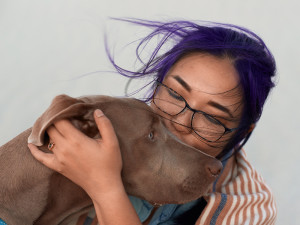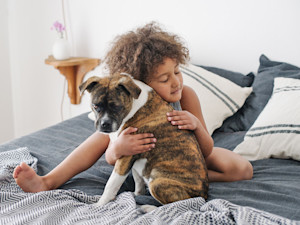What to Do, Practically, When Your Pet Dies
It might not be something you ever want to think about, but planning ahead will be a help when the time comes

Share Article
Trigger warning: this article discusses grief and loss in depth.
Losing a pet is one of the most heart-wrenching experiences a pet parent can face. Our furry companions are not just animals; they are family, confidants and sources of unconditional love. The grief that follows their passing can be overwhelming, just like losing any close friend or family member.

Get (totally free) deals for food, treats, accessories, tech and way more pet parenting must-haves.
opens in a new tabUnfortunately, in the midst of the emotional turmoil, practical steps need to be taken to ensure that your beloved companion is handled with dignity and care. It’s not just about the immediate aftermath of your pet’s passing, but also about making decisions that honour your pet and support your own emotional well-being in the long run, too. Whilst it’s not something you would ever choose to think about, the fact that you may have done so ahead of time will be a reassuring relief when the time finally comes and you’re dealing with lots of emotions.
The process of saying goodbye to a pet can vary greatly depending on the circumstances of their passing and your personal preferences. Whether your pet’s death was expected or sudden, at home or elsewhere, there are important considerations to take into account. We’re here to guide you through the difficult time with compassionate advice on the practical steps to take when your pet dies, helping you to manage both the logistical and emotional aspects of a time we hope never has to happen.
Immediate steps after your pet passes away
First things first, take a deep breath. Your four-legged friend may have crossed the rainbow bridge, but you’re still here and need to handle things. Veterinary nurse Zoe Blake advises, “Allow yourself the time to process what has happened. Emotions can run rife; from sadness and guilt, to even relief if the pet had been suffering.” Once you’ve given yourself a moment, here are some immediate steps to follow:
Confirm the passing: ensure your pet has indeed passed away. Check for signs of breathing or a heartbeat. It might sound morbid, and the last thing you’d want to do, but it’s essential. If you’re unsure, seek help from a friend or family member or medical professional if one is available.
Prepare the body: “the body will sadly leak body fluids so the first thing to do would be to place them on a towel or blanket,” says Zoe. “Ensure that you use a blanket that is big enough to wrap around the body and keep them safe whilst you make further arrangements.”
Notify your vet: inform your vet about your pet’s passing. They can guide you through the next steps and discuss options for handling your pet’s remains.
Seek assistance: if your pet dies outside, for instance, you may want to transport your pet back home, to your vehicle, or to the vets. This can be emotionally and physically taxing, so don’t hesitate to ask for help. Call your vet to discuss the best course of action. Vets can often arrange for a discreet visit to avoid a distressing waiting room experience at busy times.
Deciding between burial and cremation
The next decision, deciding how to say goodbye to your pet, is deeply personal and may depend on various factors including your living situation, financial considerations, religion and emotional readiness.
Choosing the right service for your pet’s final journey is vital. Many vets will have preferred cremation services if you don’t know where to start (you’re not obligated to use them), and will be able to point you in the right direction for local pet cemeteriesopens in a new tab. Here are some things to consider before making your decision:
Do your research: look for local services and read reviews. Visit the facilities if possible to get a feel for the place.
Ask questions: enquire about their processes, costs and if they offer additional services such as memorials or keepsakes.
Consider costs: cremation and burial can be expensive. Make sure you’re aware of all costs involved to avoid any surprises.
Cremation
Cremation is a popular choice, with pet crematoriums offering both communal and individual options. “You can take your pet’s body to your vet or call the pet crematorium to arrange cremation,” explains Dr Nina Cooke, an emergency care vet. “They will usually collect your pet from home,” she adds, or you can make travel arrangements of your own.
It’s worth noting that in the UK the most common option for pets is communal cremation, and often the ashes are not returned. Depending on the service provider, you may be able to receive ashes in these instances but there is also a chance that the ashes won’t only be your pet. Individual cremation means your pet is cremated alone and allows you to keep their ashes, perhaps in a special urn or to be scattered in a favourite spot, but costs more.
Communal cremation costs vary from £100–200 depending on your location and the size of your pet, and can go up to £350 for individual cremations depending on the same parameters, as well as the type of urn and any additional services you might want. “Always be aware of the costs associated so that you can set aside funds,” says Zoe.
For those in rented accommodation, or for urban dwellers, “cremation may be your only option,“ says Zoe. ”Unless you are lucky enough to have a pet cemetery close by.” In such cases, look for reputable cremation services and consider options for keeping your pet’s ashes.
Burial
If you prefer a burial, there are a number of options and some regulations to consider before you decide on your pet’s final resting place. You can do so at home, provided you own the land. But before you dig a hole in your garden, make sure to check local regulations as some areas have specific requirements for pet burials.
“You can bury your pet at home providing you own the land and it’s away from water sources,” says Dr Cooke. “Don’t underestimate this task; the hole needs to be deep with at least 2–3 feet of soil covering the body.”
Regulations vary, but generally, pets must be buried at least 3–5 feet deep (2–3 feet of soil above the body) to prevent scavenging and ensure sanitary conditions and burial sites should be away from water sources such as rivers, lakes and wells.
Alternatively, pet cemeteries offer a dedicated space for your pet’s final resting place. “Check what the local laws are regarding burial”, says Zoe. “There are some pet cemeteries and some authorities that may allow pets to be buried alongside their humans.”
Preparing for your pet’s death
It’s never easy to think about death, but some emotional and practical preparation can help ease the pain when the time comes.
Emotional preparation
Understanding your pet’s lifespan and health can help you mentally prepare for their eventual passing. Discussing end-of-life care with your vet is crucial. “Talk with family members about your pet’s health and what to expect,” Zoe advises. These conversations, though difficult, are necessary to ensure everyone is prepared.
Talk to family members about what to expect when your pet is starting any end-of-life care, using age-appropriate language for childrenopens in a new tab. “When my son first went through a pet bereavement, I told him that they go to the rainbow,” says Zoe, “so every time we see a rainbow now, he waves to it and says hello to all his animal friends, which there are quite a few now.”
Practical preparation
Create a comfortable, quiet space for your pet as they approach the end of life. Document your preferences for their end-of-life care, including palliative care, euthanasia and hospice services, and share this plan with family members and your vet. It might not be something you want to think about at any point, but the planning and forethought will help to provide clarity and peace of mind during an emotionally charged time when the inevitable does come.
Financial considerations
Understanding the costs associated with pet burial or cremation is crucial. These services can vary widely in price, and it’s wise to set aside funds in advance. This financial planning will alleviate some stress during an already challenging time.
Depending on your policy and the type of cover you take out, some insurance companies will cover the death of a pet due to injury or illness, however this usually only applies up to a certain age (which is policy-dependent). Some pet insurance providers will also cover the cost of cremation, or it is sometimes offered as a policy add-on. Speak to your insurance provider if you’re unsure of what is covered for your pet, and make a note to cancel the policy after you have said your final goodbyes to your pet.
How to say goodbye to your pet
Allow yourself a moment to process what has happened. Emotions will be raw and varied, so take a breath, acknowledge your feelings and give yourself permission to grieve. Whether you choose burial or cremation, the most important thing is that you’re able to say goodbye in a respectful way that’s personal to you.
Remember, your pet was a beloved member of your family, and taking the time to honour their life and process your grief is a crucial part of saying goodbye. In the words of Zoe, “Death is sadly a natural part of life and this is something that needs to be accepted when the time comes.” Embrace the memories, seek support and give yourself grace during this challenging time.
Make lasting memories
Consider creating keepsakes to remember your pet. Paw prints, locks of fur or memorial jewellery can provide comfort and a tangible connection to your pet after they pass. These mementos can be a source of solace as you navigate through grief.
Holding a small ceremony or gathering in your pet’s honour can be a meaningful way to say goodbye, or can be an appropriate way of spreading your pet’s ashes (if they are cremated). This can be a private moment or include friends and family who shared a bond with your pet. Celebrating their life and the joy they brought can sometimes provide closure.
Supporting your mental well-being
Grief is a natural response to losing a beloved pet. Seek support from friends, family or pet loss support groups. “Taking care of your emotional well-being is important during this time,” says Zoe. If you are struggling to cope, do not hesitate to reach out for help. Pet loss can trigger profound griefopens in a new tab, and there is no shame in seeking professional support. Many therapists specialise in pet bereavement and can provide valuable guidance.

Orla Pentelow
Orla Pentelow is Kinship UK’s Senior Editor. She has previously written for British Vogue, Bustle, Yahoo and The Telegraph. When not at her desk liking dog videos she’s out and about with her rescue pup, Luna, who works primarily as chief distractor.
Related articles
![Woman with purple hair kissing the face of her chocolate brown hound dog]() opens in a new tab
opens in a new tab8 Comforting Thoughts to Help You Through the Death of Your Pet
There’s no guidebook to grief and loss – but these kind words will help
![a black and white dog on lead sits in a misty graveyard]() opens in a new tab
opens in a new tabShould You Walk Your Dog In a Cemetery?
People are questioning not just if you’re allowed to walk your dog in a graveyard, but whether you should
![A dog resting its face on a wooden table.]() opens in a new tab
opens in a new tabDo Dogs Grieve When Other Dogs Die?
A new study confirms our pets can have heartbreaking reactions to the loss of a canine companion
![Portrait Of Large, Senior, Mixed Breed Dog On Beach]() opens in a new tab
opens in a new tab10 Tips for Grieving a Pet
We asked five grief experts how to cope with feelings of guilt after we lose a pet
![a small child with curly hair hugs a dog on a bed]() opens in a new tab
opens in a new tabHelping Your Child Deal With The Grief of Losing a Pet
When it’s time to say goodbye…






